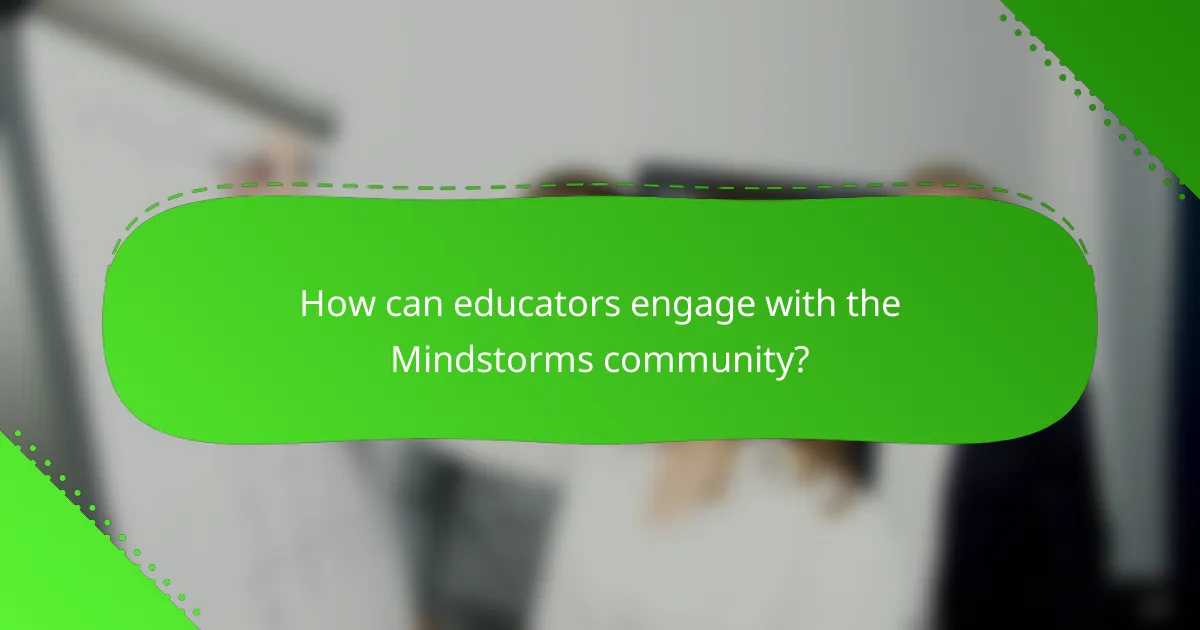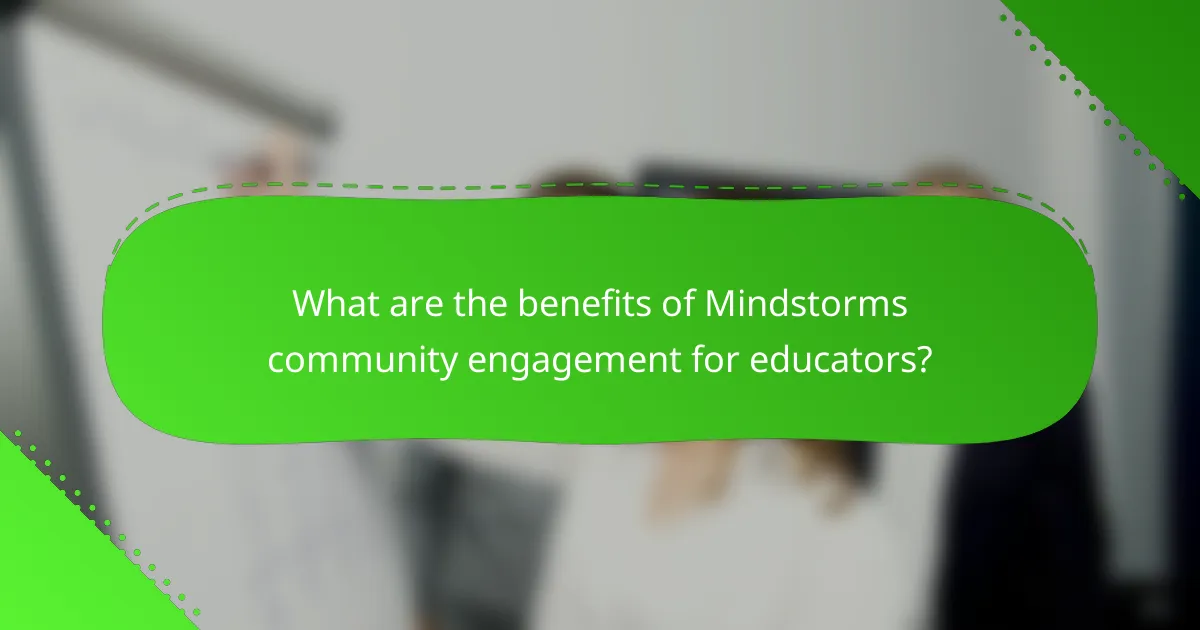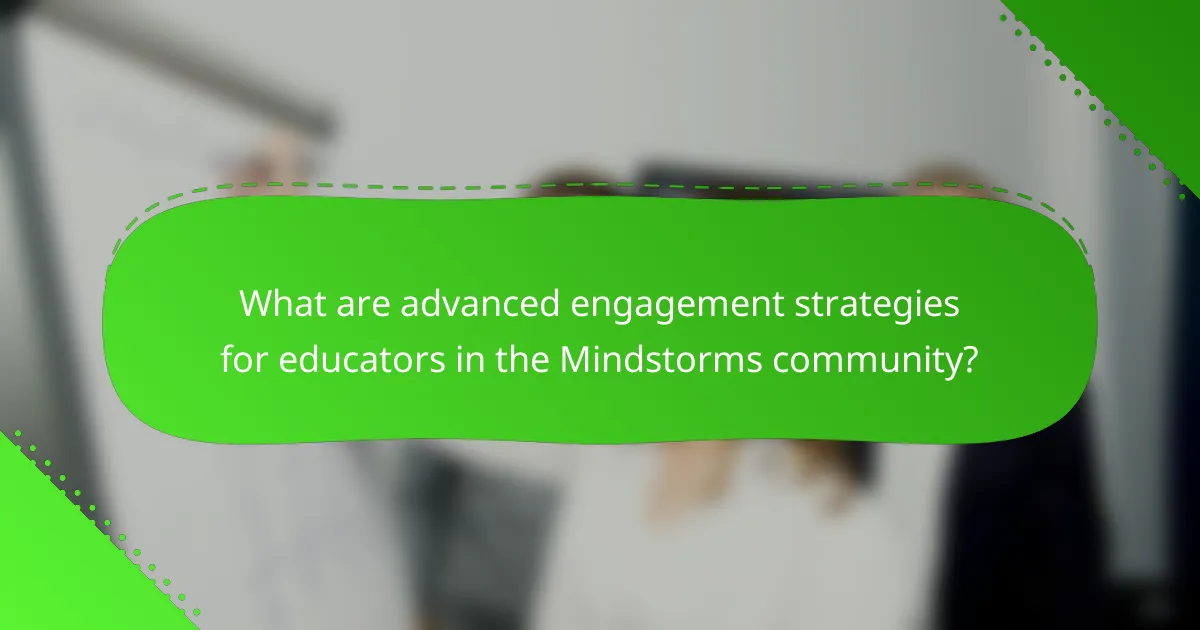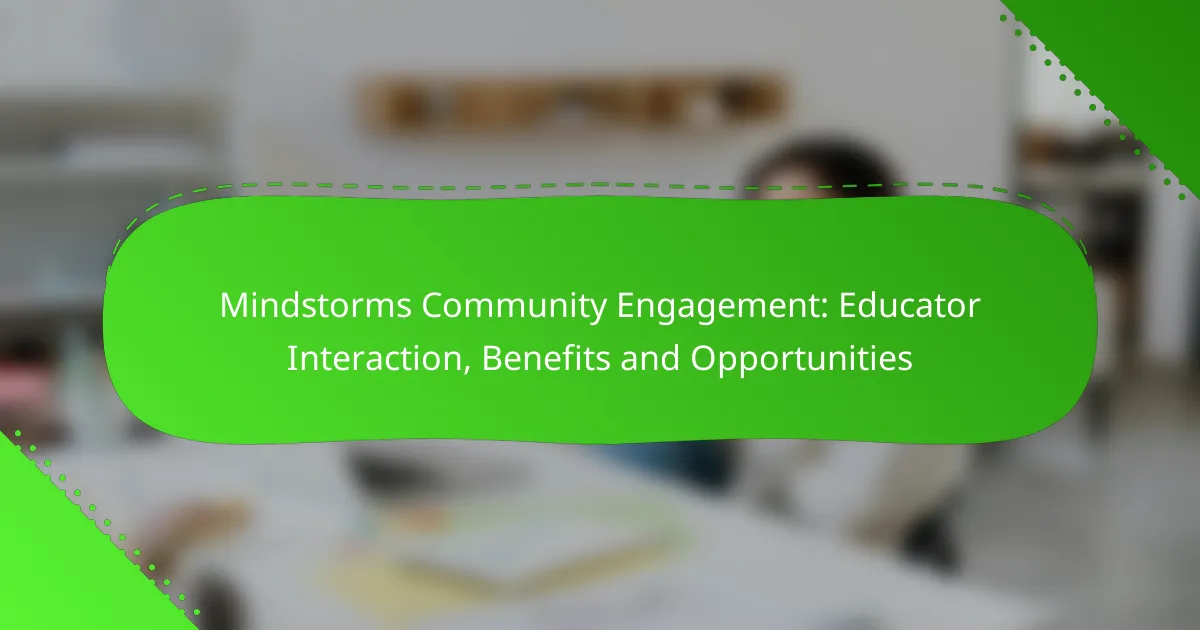The Mindstorms community provides educators with a vibrant platform for collaboration and knowledge sharing, enhancing their teaching practices through professional development and innovative project ideas. By engaging with this community, educators can access valuable resources, network with peers, and participate in enriching activities that benefit both themselves and their students.

How can educators engage with the Mindstorms community?
Educators can engage with the Mindstorms community through various platforms and activities that foster collaboration and knowledge sharing. These interactions provide opportunities for professional development, resource sharing, and innovative project ideas.
Online forums and discussion groups
Online forums and discussion groups are vital for educators to connect with peers and share insights about Mindstorms. Platforms like the LEGO Education community forum allow users to ask questions, exchange lesson plans, and discuss best practices.
Participating in these forums can help educators stay updated on new resources and tools. Regular engagement can lead to valuable networking opportunities and collaborations on educational projects.
Workshops and training sessions
Workshops and training sessions offer hands-on experience with Mindstorms products and teaching methodologies. Many organizations, including LEGO Education, host events that provide educators with practical skills and knowledge to enhance their teaching.
These sessions often cover topics such as programming, robotics integration in the classroom, and curriculum development. Attending workshops can significantly boost an educator’s confidence and effectiveness in using Mindstorms in their teaching.
Collaborative projects and challenges
Collaborative projects and challenges encourage educators to work together on innovative solutions using Mindstorms. These initiatives can range from local competitions to global challenges that promote STEM education.
By participating in these projects, educators can share resources and learn from each other’s experiences. Engaging in challenges can also motivate students and enhance their learning through teamwork and problem-solving.
Social media interactions
Social media platforms like Twitter, Facebook, and Instagram are excellent venues for educators to engage with the Mindstorms community. Educators can follow relevant hashtags, join groups, and share their experiences and resources with a broader audience.
These interactions can lead to the discovery of new teaching strategies and connections with other educators worldwide. Regularly sharing insights and successes can inspire others and foster a supportive community around Mindstorms education.

What are the benefits of Mindstorms community engagement for educators?
Mindstorms community engagement offers educators valuable resources, networking opportunities, and innovative teaching methodologies. By participating in this community, educators can enhance their teaching practices and connect with like-minded professionals.
Access to resources and materials
Engaging with the Mindstorms community provides educators with access to a wealth of resources and materials, including lesson plans, project ideas, and instructional videos. These resources can help educators integrate robotics into their curriculum more effectively.
Additionally, community members often share their own created materials, which can include templates, coding examples, and troubleshooting guides. This collaborative sharing fosters a rich learning environment where educators can find inspiration and practical tools to enhance their teaching.
Networking opportunities with peers
Mindstorms community engagement allows educators to network with peers from various educational backgrounds. This interaction can lead to the sharing of best practices, collaborative projects, and even mentorship opportunities.
Participating in forums, workshops, and local meetups can help educators build relationships that extend beyond their immediate environment. These connections can lead to partnerships that enhance educational experiences for students, such as joint projects or competitions.
Enhanced teaching methodologies
Through community engagement, educators can discover innovative teaching methodologies that incorporate robotics and coding into their classrooms. This exposure can lead to more interactive and hands-on learning experiences for students.
Educators can learn about different approaches, such as project-based learning or inquiry-based learning, which can be particularly effective in teaching complex concepts. By adopting these methodologies, educators can foster critical thinking and problem-solving skills in their students, preparing them for future challenges.

What opportunities exist for collaboration within the Mindstorms community?
The Mindstorms community offers various collaboration opportunities that enhance educational experiences for both educators and students. These include partnerships with educational institutions, participation in competitions and events, and contributions to curriculum development.
Partnerships with educational institutions
Collaborating with educational institutions can provide educators access to resources, expertise, and support for implementing Mindstorms in their classrooms. Schools can partner with local universities or tech organizations to develop programs that integrate robotics into their curricula.
These partnerships often lead to shared workshops, training sessions, and mentorship opportunities, allowing educators to enhance their teaching methods. For example, a partnership might involve a university providing guest lectures or hands-on workshops for teachers, fostering a deeper understanding of robotics.
Participation in competitions and events
Engaging in competitions and events is a significant way for educators and students to showcase their skills and creativity using Mindstorms. These events, such as robotics competitions or hackathons, encourage teamwork and problem-solving while providing a platform for students to demonstrate their projects.
Participation can also lead to networking opportunities with other educators and industry professionals. Educators should consider joining local or national competitions to motivate their students and gain recognition for their programs.
Contribution to curriculum development
Educators can play a vital role in shaping the curriculum by integrating Mindstorms into their teaching frameworks. This involves collaborating with other educators to develop lesson plans and projects that align with educational standards and learning objectives.
By contributing to curriculum development, educators can ensure that robotics education meets the needs of their students and prepares them for future challenges. Sharing successful lesson plans and resources within the Mindstorms community can also inspire others to adopt similar approaches.

What criteria should educators consider when joining the Mindstorms community?
Educators should evaluate their alignment with the Mindstorms community’s educational goals, as well as the availability of support and resources. These criteria will help ensure that their participation is both effective and beneficial for their teaching practices.
Alignment with educational goals
When considering joining the Mindstorms community, educators should assess how the platform’s objectives align with their own educational goals. This includes evaluating whether the community promotes hands-on learning, critical thinking, and collaboration, which are essential in modern education.
For example, if an educator aims to enhance STEM education in their curriculum, they should look for resources and community activities that emphasize robotics and programming. Ensuring this alignment can lead to more meaningful engagement and improved student outcomes.
Availability of support and resources
Access to support and resources is crucial for educators in the Mindstorms community. They should investigate the types of training, tutorials, and community forums available to assist them in implementing Mindstorms in their classrooms.
Educators might benefit from structured workshops or online courses that provide hands-on experience with Mindstorms kits. Additionally, connecting with other educators who share similar goals can foster collaboration and idea exchange, enhancing the overall learning experience.

How does Mindstorms enhance STEM education?
Mindstorms enhances STEM education by providing interactive tools and resources that foster creativity, critical thinking, and problem-solving skills among students. By engaging learners in hands-on robotics projects, it effectively bridges theoretical concepts with practical applications.
Hands-on learning experiences
Hands-on learning experiences are central to Mindstorms, allowing students to build and program robots while applying STEM principles. This active engagement not only solidifies understanding but also boosts motivation and retention of knowledge.
For example, students can work in teams to design a robot that completes specific tasks, encouraging collaboration and communication. Such projects often lead to a deeper grasp of mechanical and programming concepts, as students see the immediate results of their efforts.
Integration of technology in the classroom
Integrating technology in the classroom through Mindstorms equips educators with innovative teaching tools that enhance traditional learning methods. By incorporating robotics, teachers can create a dynamic learning environment that appeals to diverse learning styles.
Educators can utilize Mindstorms to align with educational standards, such as the Next Generation Science Standards (NGSS) in the U.S., which emphasize hands-on activities and real-world applications. This integration not only prepares students for future careers in technology but also cultivates essential skills like coding and engineering design.

What are advanced engagement strategies for educators in the Mindstorms community?
Advanced engagement strategies for educators in the Mindstorms community involve leveraging collaborative tools, hands-on projects, and digital resources to enhance learning experiences. These strategies foster interaction among educators and students, promoting creativity and problem-solving skills.
Collaborative Learning Opportunities
Collaborative learning opportunities allow educators to work together on projects that integrate Mindstorms technology. By forming partnerships, teachers can share resources, ideas, and best practices, enriching the educational experience for their students. For example, joint workshops can be organized where educators from different schools come together to develop lesson plans that utilize Mindstorms kits.
Additionally, online platforms can facilitate collaboration, enabling educators to connect globally. This can lead to the exchange of innovative teaching methods and the development of cross-cultural projects that engage students in meaningful ways.
Hands-On Workshops and Training
Hands-on workshops and training sessions are vital for educators to effectively implement Mindstorms in their classrooms. These sessions provide practical experience with the technology, allowing teachers to understand its capabilities and limitations. Workshops can range from a few hours to several days, depending on the depth of training required.
Educators should seek out workshops that offer certification or professional development credits, as this can enhance their credentials. Local education authorities or Mindstorms community groups often sponsor these events, making them accessible and relevant to current educational standards.
Utilizing Digital Resources
Utilizing digital resources is essential for maximizing the potential of Mindstorms in education. Online forums, instructional videos, and lesson plan repositories can provide educators with valuable insights and inspiration. Websites dedicated to robotics education often feature user-generated content, allowing teachers to adapt successful projects for their classrooms.
Educators should also consider creating a digital library of resources that can be shared within their school or district. This collaborative approach not only saves time but also builds a supportive community of practice among educators who are passionate about robotics and technology.
